University Assignment: Coercive Mental Health Practices and Sedatives
VerifiedAdded on 2022/08/29
|11
|3243
|8
Essay
AI Summary
This essay critically analyzes the controversial use of sedative psychotropic medications in managing the behaviors of mental health patients, highlighting the associated restrictive and coercive practices. It delves into the impact of these practices, exploring the arguments for and against their use, ...

Running head: COERCIVE MENTAL HEALTH PRACTICES
Sedatives and restrictive behavior
Name of the Student:
Name of the University:
Author Note:
Sedatives and restrictive behavior
Name of the Student:
Name of the University:
Author Note:
Paraphrase This Document
Need a fresh take? Get an instant paraphrase of this document with our AI Paraphraser
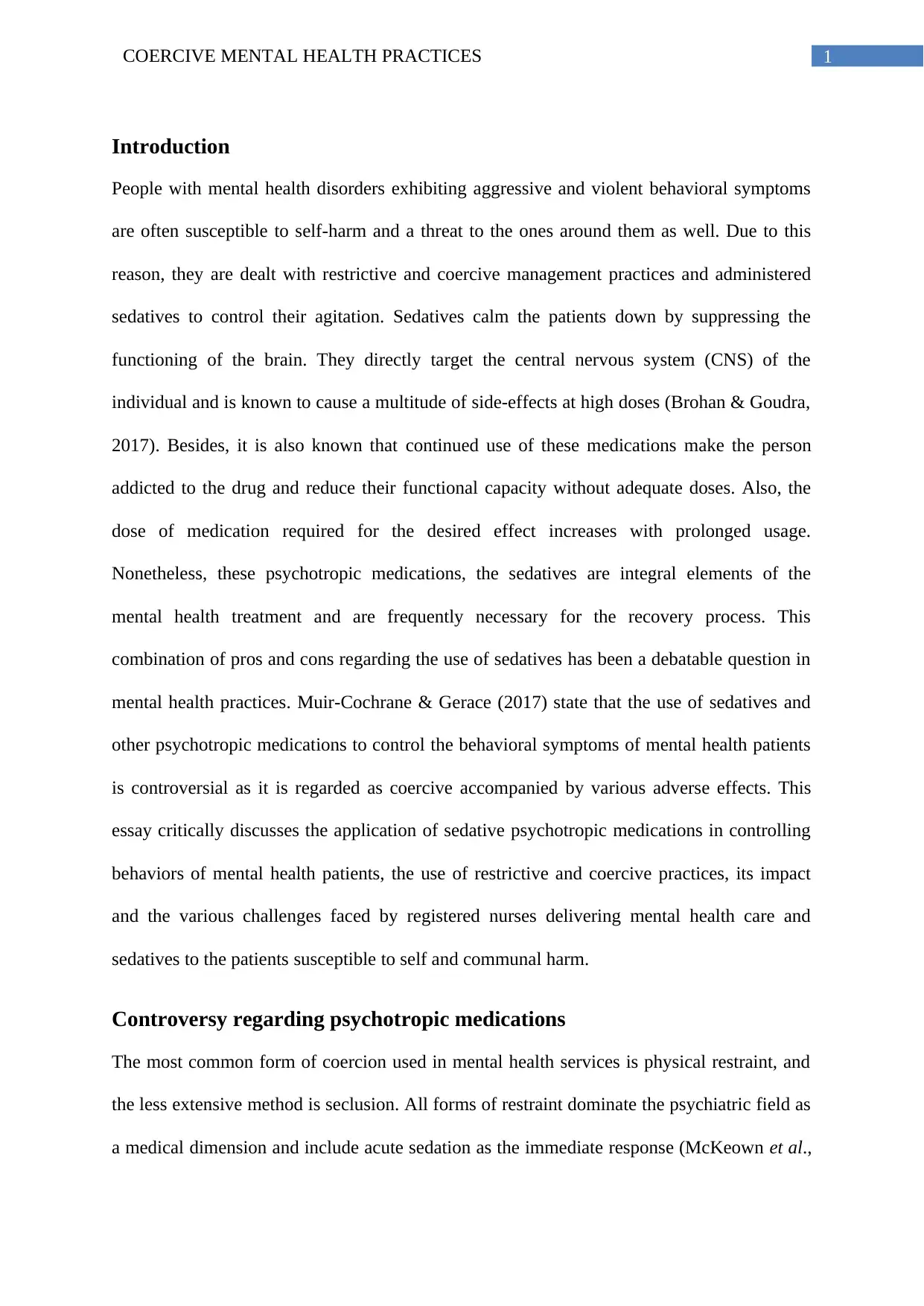
1COERCIVE MENTAL HEALTH PRACTICES
Introduction
People with mental health disorders exhibiting aggressive and violent behavioral symptoms
are often susceptible to self-harm and a threat to the ones around them as well. Due to this
reason, they are dealt with restrictive and coercive management practices and administered
sedatives to control their agitation. Sedatives calm the patients down by suppressing the
functioning of the brain. They directly target the central nervous system (CNS) of the
individual and is known to cause a multitude of side-effects at high doses (Brohan & Goudra,
2017). Besides, it is also known that continued use of these medications make the person
addicted to the drug and reduce their functional capacity without adequate doses. Also, the
dose of medication required for the desired effect increases with prolonged usage.
Nonetheless, these psychotropic medications, the sedatives are integral elements of the
mental health treatment and are frequently necessary for the recovery process. This
combination of pros and cons regarding the use of sedatives has been a debatable question in
mental health practices. Muir-Cochrane & Gerace (2017) state that the use of sedatives and
other psychotropic medications to control the behavioral symptoms of mental health patients
is controversial as it is regarded as coercive accompanied by various adverse effects. This
essay critically discusses the application of sedative psychotropic medications in controlling
behaviors of mental health patients, the use of restrictive and coercive practices, its impact
and the various challenges faced by registered nurses delivering mental health care and
sedatives to the patients susceptible to self and communal harm.
Controversy regarding psychotropic medications
The most common form of coercion used in mental health services is physical restraint, and
the less extensive method is seclusion. All forms of restraint dominate the psychiatric field as
a medical dimension and include acute sedation as the immediate response (McKeown et al.,
Introduction
People with mental health disorders exhibiting aggressive and violent behavioral symptoms
are often susceptible to self-harm and a threat to the ones around them as well. Due to this
reason, they are dealt with restrictive and coercive management practices and administered
sedatives to control their agitation. Sedatives calm the patients down by suppressing the
functioning of the brain. They directly target the central nervous system (CNS) of the
individual and is known to cause a multitude of side-effects at high doses (Brohan & Goudra,
2017). Besides, it is also known that continued use of these medications make the person
addicted to the drug and reduce their functional capacity without adequate doses. Also, the
dose of medication required for the desired effect increases with prolonged usage.
Nonetheless, these psychotropic medications, the sedatives are integral elements of the
mental health treatment and are frequently necessary for the recovery process. This
combination of pros and cons regarding the use of sedatives has been a debatable question in
mental health practices. Muir-Cochrane & Gerace (2017) state that the use of sedatives and
other psychotropic medications to control the behavioral symptoms of mental health patients
is controversial as it is regarded as coercive accompanied by various adverse effects. This
essay critically discusses the application of sedative psychotropic medications in controlling
behaviors of mental health patients, the use of restrictive and coercive practices, its impact
and the various challenges faced by registered nurses delivering mental health care and
sedatives to the patients susceptible to self and communal harm.
Controversy regarding psychotropic medications
The most common form of coercion used in mental health services is physical restraint, and
the less extensive method is seclusion. All forms of restraint dominate the psychiatric field as
a medical dimension and include acute sedation as the immediate response (McKeown et al.,
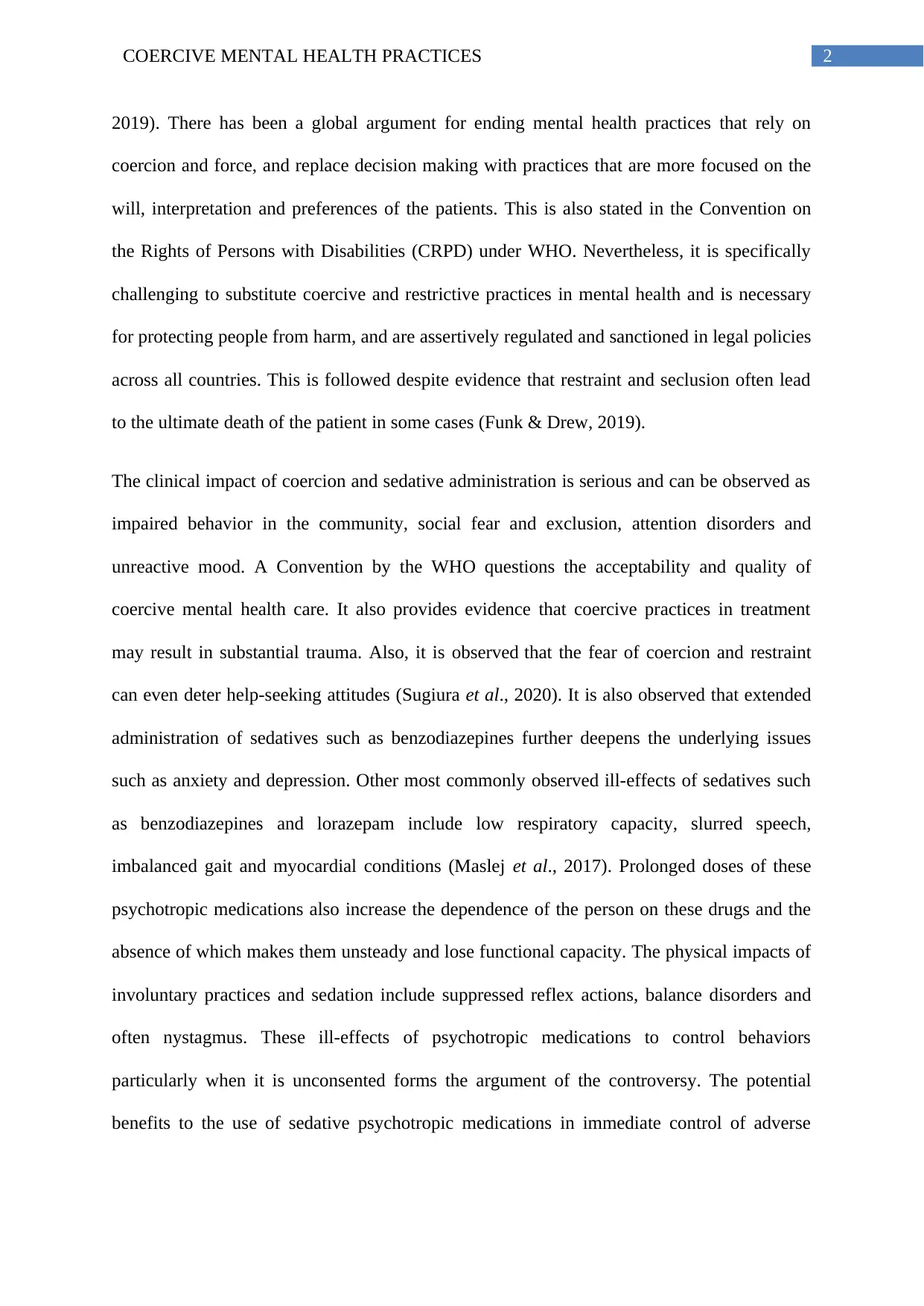
2COERCIVE MENTAL HEALTH PRACTICES
2019). There has been a global argument for ending mental health practices that rely on
coercion and force, and replace decision making with practices that are more focused on the
will, interpretation and preferences of the patients. This is also stated in the Convention on
the Rights of Persons with Disabilities (CRPD) under WHO. Nevertheless, it is specifically
challenging to substitute coercive and restrictive practices in mental health and is necessary
for protecting people from harm, and are assertively regulated and sanctioned in legal policies
across all countries. This is followed despite evidence that restraint and seclusion often lead
to the ultimate death of the patient in some cases (Funk & Drew, 2019).
The clinical impact of coercion and sedative administration is serious and can be observed as
impaired behavior in the community, social fear and exclusion, attention disorders and
unreactive mood. A Convention by the WHO questions the acceptability and quality of
coercive mental health care. It also provides evidence that coercive practices in treatment
may result in substantial trauma. Also, it is observed that the fear of coercion and restraint
can even deter help-seeking attitudes (Sugiura et al., 2020). It is also observed that extended
administration of sedatives such as benzodiazepines further deepens the underlying issues
such as anxiety and depression. Other most commonly observed ill-effects of sedatives such
as benzodiazepines and lorazepam include low respiratory capacity, slurred speech,
imbalanced gait and myocardial conditions (Maslej et al., 2017). Prolonged doses of these
psychotropic medications also increase the dependence of the person on these drugs and the
absence of which makes them unsteady and lose functional capacity. The physical impacts of
involuntary practices and sedation include suppressed reflex actions, balance disorders and
often nystagmus. These ill-effects of psychotropic medications to control behaviors
particularly when it is unconsented forms the argument of the controversy. The potential
benefits to the use of sedative psychotropic medications in immediate control of adverse
2019). There has been a global argument for ending mental health practices that rely on
coercion and force, and replace decision making with practices that are more focused on the
will, interpretation and preferences of the patients. This is also stated in the Convention on
the Rights of Persons with Disabilities (CRPD) under WHO. Nevertheless, it is specifically
challenging to substitute coercive and restrictive practices in mental health and is necessary
for protecting people from harm, and are assertively regulated and sanctioned in legal policies
across all countries. This is followed despite evidence that restraint and seclusion often lead
to the ultimate death of the patient in some cases (Funk & Drew, 2019).
The clinical impact of coercion and sedative administration is serious and can be observed as
impaired behavior in the community, social fear and exclusion, attention disorders and
unreactive mood. A Convention by the WHO questions the acceptability and quality of
coercive mental health care. It also provides evidence that coercive practices in treatment
may result in substantial trauma. Also, it is observed that the fear of coercion and restraint
can even deter help-seeking attitudes (Sugiura et al., 2020). It is also observed that extended
administration of sedatives such as benzodiazepines further deepens the underlying issues
such as anxiety and depression. Other most commonly observed ill-effects of sedatives such
as benzodiazepines and lorazepam include low respiratory capacity, slurred speech,
imbalanced gait and myocardial conditions (Maslej et al., 2017). Prolonged doses of these
psychotropic medications also increase the dependence of the person on these drugs and the
absence of which makes them unsteady and lose functional capacity. The physical impacts of
involuntary practices and sedation include suppressed reflex actions, balance disorders and
often nystagmus. These ill-effects of psychotropic medications to control behaviors
particularly when it is unconsented forms the argument of the controversy. The potential
benefits to the use of sedative psychotropic medications in immediate control of adverse
⊘ This is a preview!⊘
Do you want full access?
Subscribe today to unlock all pages.

Trusted by 1+ million students worldwide
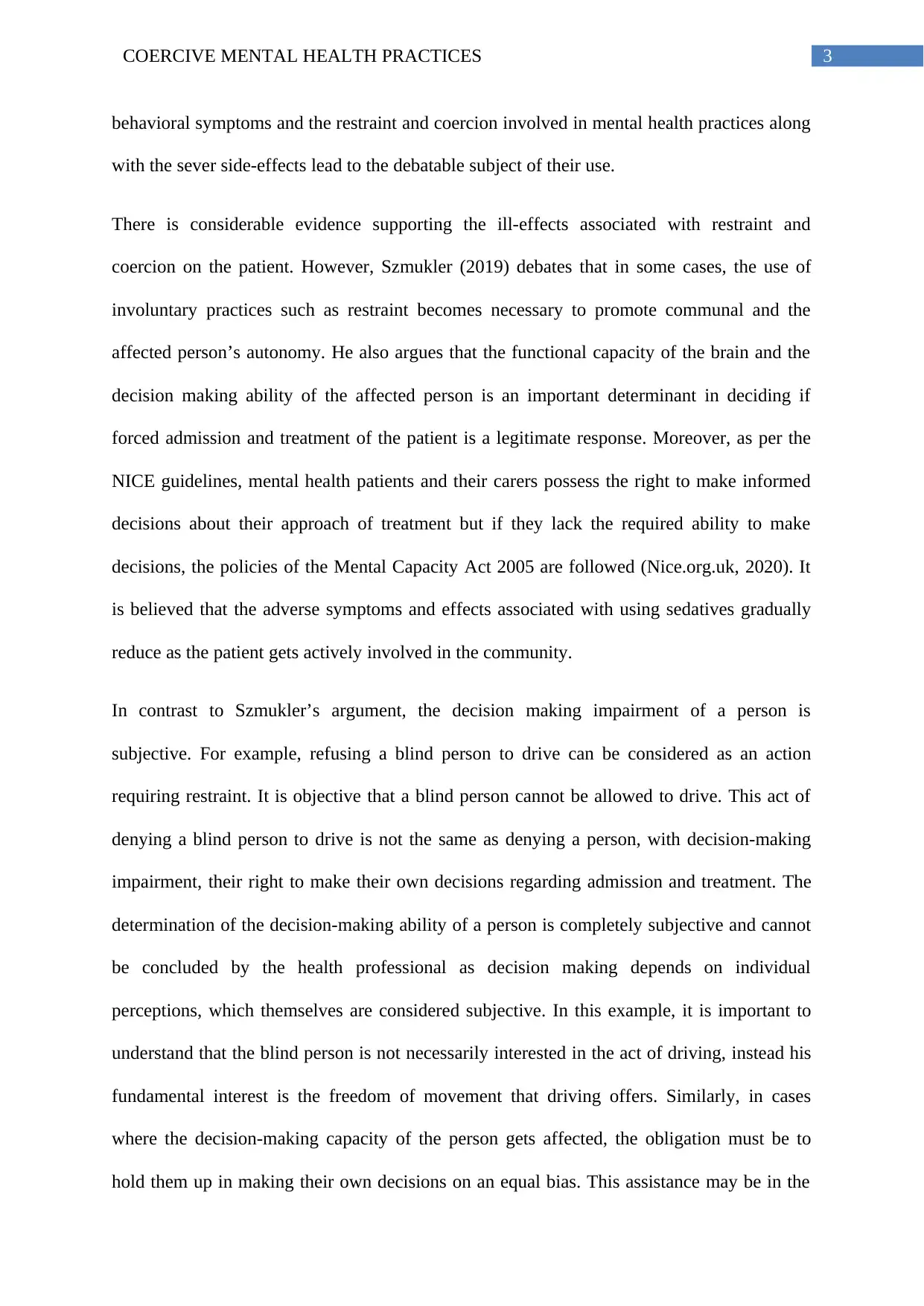
3COERCIVE MENTAL HEALTH PRACTICES
behavioral symptoms and the restraint and coercion involved in mental health practices along
with the sever side-effects lead to the debatable subject of their use.
There is considerable evidence supporting the ill-effects associated with restraint and
coercion on the patient. However, Szmukler (2019) debates that in some cases, the use of
involuntary practices such as restraint becomes necessary to promote communal and the
affected person’s autonomy. He also argues that the functional capacity of the brain and the
decision making ability of the affected person is an important determinant in deciding if
forced admission and treatment of the patient is a legitimate response. Moreover, as per the
NICE guidelines, mental health patients and their carers possess the right to make informed
decisions about their approach of treatment but if they lack the required ability to make
decisions, the policies of the Mental Capacity Act 2005 are followed (Nice.org.uk, 2020). It
is believed that the adverse symptoms and effects associated with using sedatives gradually
reduce as the patient gets actively involved in the community.
In contrast to Szmukler’s argument, the decision making impairment of a person is
subjective. For example, refusing a blind person to drive can be considered as an action
requiring restraint. It is objective that a blind person cannot be allowed to drive. This act of
denying a blind person to drive is not the same as denying a person, with decision-making
impairment, their right to make their own decisions regarding admission and treatment. The
determination of the decision-making ability of a person is completely subjective and cannot
be concluded by the health professional as decision making depends on individual
perceptions, which themselves are considered subjective. In this example, it is important to
understand that the blind person is not necessarily interested in the act of driving, instead his
fundamental interest is the freedom of movement that driving offers. Similarly, in cases
where the decision-making capacity of the person gets affected, the obligation must be to
hold them up in making their own decisions on an equal bias. This assistance may be in the
behavioral symptoms and the restraint and coercion involved in mental health practices along
with the sever side-effects lead to the debatable subject of their use.
There is considerable evidence supporting the ill-effects associated with restraint and
coercion on the patient. However, Szmukler (2019) debates that in some cases, the use of
involuntary practices such as restraint becomes necessary to promote communal and the
affected person’s autonomy. He also argues that the functional capacity of the brain and the
decision making ability of the affected person is an important determinant in deciding if
forced admission and treatment of the patient is a legitimate response. Moreover, as per the
NICE guidelines, mental health patients and their carers possess the right to make informed
decisions about their approach of treatment but if they lack the required ability to make
decisions, the policies of the Mental Capacity Act 2005 are followed (Nice.org.uk, 2020). It
is believed that the adverse symptoms and effects associated with using sedatives gradually
reduce as the patient gets actively involved in the community.
In contrast to Szmukler’s argument, the decision making impairment of a person is
subjective. For example, refusing a blind person to drive can be considered as an action
requiring restraint. It is objective that a blind person cannot be allowed to drive. This act of
denying a blind person to drive is not the same as denying a person, with decision-making
impairment, their right to make their own decisions regarding admission and treatment. The
determination of the decision-making ability of a person is completely subjective and cannot
be concluded by the health professional as decision making depends on individual
perceptions, which themselves are considered subjective. In this example, it is important to
understand that the blind person is not necessarily interested in the act of driving, instead his
fundamental interest is the freedom of movement that driving offers. Similarly, in cases
where the decision-making capacity of the person gets affected, the obligation must be to
hold them up in making their own decisions on an equal bias. This assistance may be in the
Paraphrase This Document
Need a fresh take? Get an instant paraphrase of this document with our AI Paraphraser
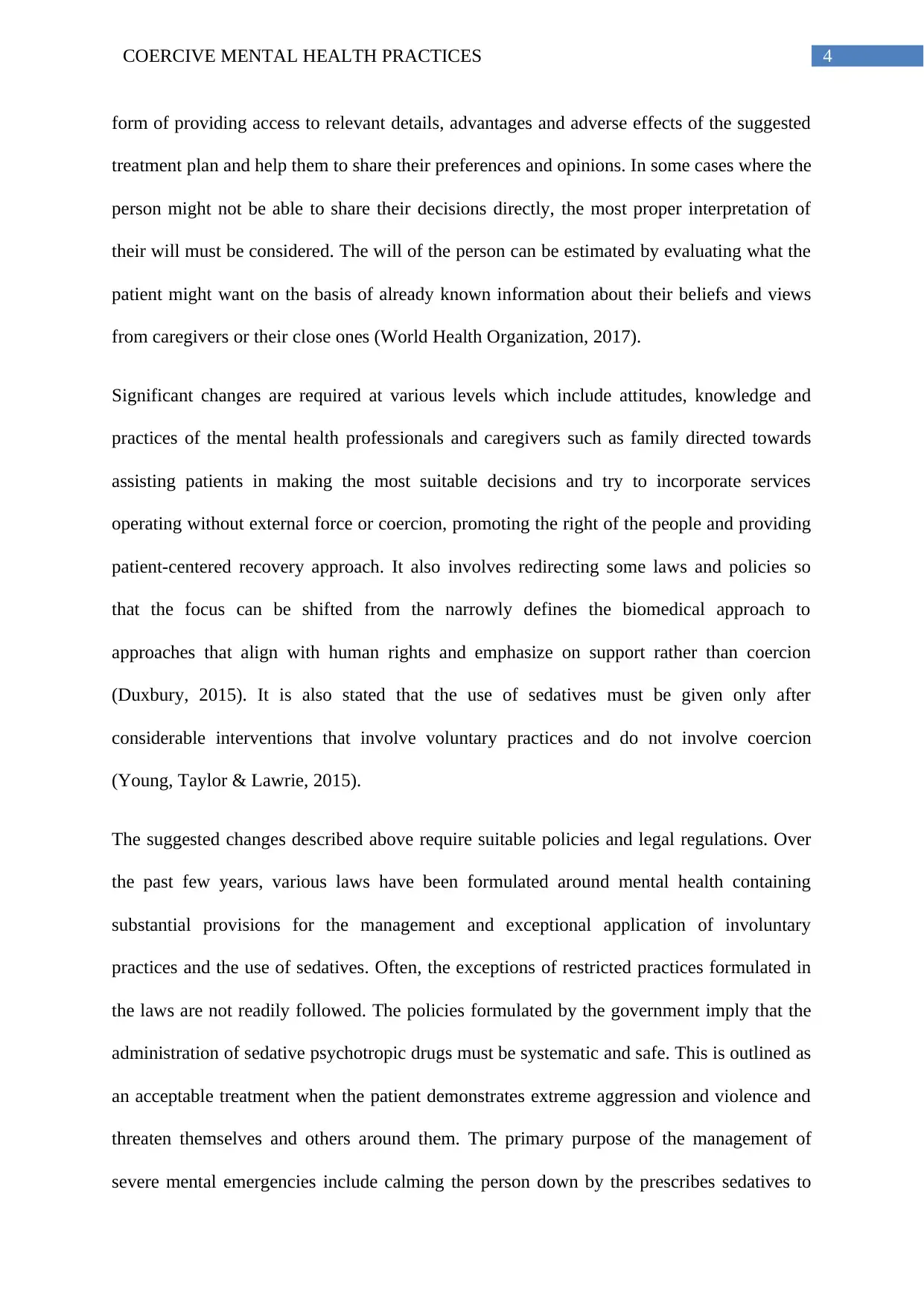
4COERCIVE MENTAL HEALTH PRACTICES
form of providing access to relevant details, advantages and adverse effects of the suggested
treatment plan and help them to share their preferences and opinions. In some cases where the
person might not be able to share their decisions directly, the most proper interpretation of
their will must be considered. The will of the person can be estimated by evaluating what the
patient might want on the basis of already known information about their beliefs and views
from caregivers or their close ones (World Health Organization, 2017).
Significant changes are required at various levels which include attitudes, knowledge and
practices of the mental health professionals and caregivers such as family directed towards
assisting patients in making the most suitable decisions and try to incorporate services
operating without external force or coercion, promoting the right of the people and providing
patient-centered recovery approach. It also involves redirecting some laws and policies so
that the focus can be shifted from the narrowly defines the biomedical approach to
approaches that align with human rights and emphasize on support rather than coercion
(Duxbury, 2015). It is also stated that the use of sedatives must be given only after
considerable interventions that involve voluntary practices and do not involve coercion
(Young, Taylor & Lawrie, 2015).
The suggested changes described above require suitable policies and legal regulations. Over
the past few years, various laws have been formulated around mental health containing
substantial provisions for the management and exceptional application of involuntary
practices and the use of sedatives. Often, the exceptions of restricted practices formulated in
the laws are not readily followed. The policies formulated by the government imply that the
administration of sedative psychotropic drugs must be systematic and safe. This is outlined as
an acceptable treatment when the patient demonstrates extreme aggression and violence and
threaten themselves and others around them. The primary purpose of the management of
severe mental emergencies include calming the person down by the prescribes sedatives to
form of providing access to relevant details, advantages and adverse effects of the suggested
treatment plan and help them to share their preferences and opinions. In some cases where the
person might not be able to share their decisions directly, the most proper interpretation of
their will must be considered. The will of the person can be estimated by evaluating what the
patient might want on the basis of already known information about their beliefs and views
from caregivers or their close ones (World Health Organization, 2017).
Significant changes are required at various levels which include attitudes, knowledge and
practices of the mental health professionals and caregivers such as family directed towards
assisting patients in making the most suitable decisions and try to incorporate services
operating without external force or coercion, promoting the right of the people and providing
patient-centered recovery approach. It also involves redirecting some laws and policies so
that the focus can be shifted from the narrowly defines the biomedical approach to
approaches that align with human rights and emphasize on support rather than coercion
(Duxbury, 2015). It is also stated that the use of sedatives must be given only after
considerable interventions that involve voluntary practices and do not involve coercion
(Young, Taylor & Lawrie, 2015).
The suggested changes described above require suitable policies and legal regulations. Over
the past few years, various laws have been formulated around mental health containing
substantial provisions for the management and exceptional application of involuntary
practices and the use of sedatives. Often, the exceptions of restricted practices formulated in
the laws are not readily followed. The policies formulated by the government imply that the
administration of sedative psychotropic drugs must be systematic and safe. This is outlined as
an acceptable treatment when the patient demonstrates extreme aggression and violence and
threaten themselves and others around them. The primary purpose of the management of
severe mental emergencies include calming the person down by the prescribes sedatives to
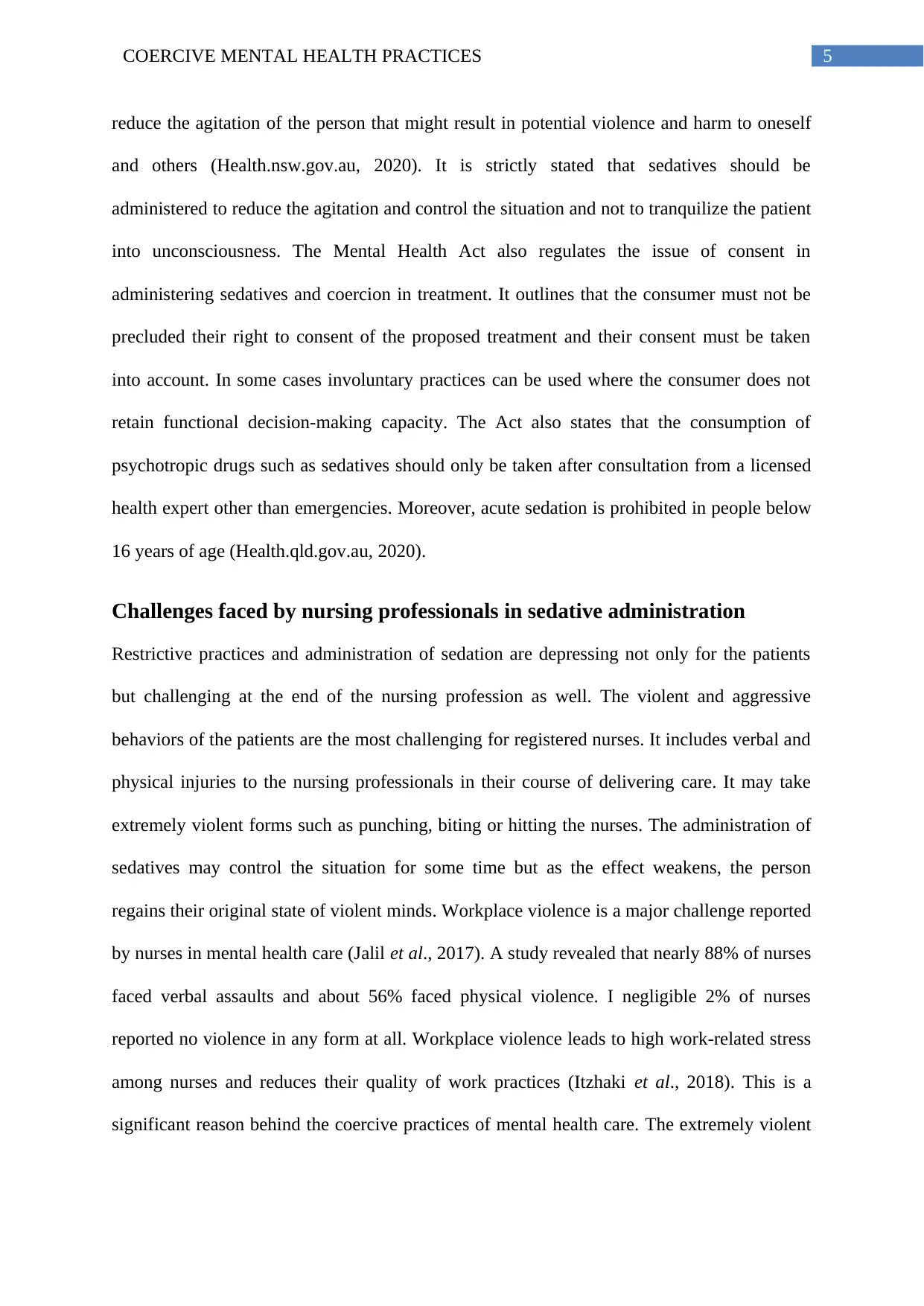
5COERCIVE MENTAL HEALTH PRACTICES
reduce the agitation of the person that might result in potential violence and harm to oneself
and others (Health.nsw.gov.au, 2020). It is strictly stated that sedatives should be
administered to reduce the agitation and control the situation and not to tranquilize the patient
into unconsciousness. The Mental Health Act also regulates the issue of consent in
administering sedatives and coercion in treatment. It outlines that the consumer must not be
precluded their right to consent of the proposed treatment and their consent must be taken
into account. In some cases involuntary practices can be used where the consumer does not
retain functional decision-making capacity. The Act also states that the consumption of
psychotropic drugs such as sedatives should only be taken after consultation from a licensed
health expert other than emergencies. Moreover, acute sedation is prohibited in people below
16 years of age (Health.qld.gov.au, 2020).
Challenges faced by nursing professionals in sedative administration
Restrictive practices and administration of sedation are depressing not only for the patients
but challenging at the end of the nursing profession as well. The violent and aggressive
behaviors of the patients are the most challenging for registered nurses. It includes verbal and
physical injuries to the nursing professionals in their course of delivering care. It may take
extremely violent forms such as punching, biting or hitting the nurses. The administration of
sedatives may control the situation for some time but as the effect weakens, the person
regains their original state of violent minds. Workplace violence is a major challenge reported
by nurses in mental health care (Jalil et al., 2017). A study revealed that nearly 88% of nurses
faced verbal assaults and about 56% faced physical violence. I negligible 2% of nurses
reported no violence in any form at all. Workplace violence leads to high work-related stress
among nurses and reduces their quality of work practices (Itzhaki et al., 2018). This is a
significant reason behind the coercive practices of mental health care. The extremely violent
reduce the agitation of the person that might result in potential violence and harm to oneself
and others (Health.nsw.gov.au, 2020). It is strictly stated that sedatives should be
administered to reduce the agitation and control the situation and not to tranquilize the patient
into unconsciousness. The Mental Health Act also regulates the issue of consent in
administering sedatives and coercion in treatment. It outlines that the consumer must not be
precluded their right to consent of the proposed treatment and their consent must be taken
into account. In some cases involuntary practices can be used where the consumer does not
retain functional decision-making capacity. The Act also states that the consumption of
psychotropic drugs such as sedatives should only be taken after consultation from a licensed
health expert other than emergencies. Moreover, acute sedation is prohibited in people below
16 years of age (Health.qld.gov.au, 2020).
Challenges faced by nursing professionals in sedative administration
Restrictive practices and administration of sedation are depressing not only for the patients
but challenging at the end of the nursing profession as well. The violent and aggressive
behaviors of the patients are the most challenging for registered nurses. It includes verbal and
physical injuries to the nursing professionals in their course of delivering care. It may take
extremely violent forms such as punching, biting or hitting the nurses. The administration of
sedatives may control the situation for some time but as the effect weakens, the person
regains their original state of violent minds. Workplace violence is a major challenge reported
by nurses in mental health care (Jalil et al., 2017). A study revealed that nearly 88% of nurses
faced verbal assaults and about 56% faced physical violence. I negligible 2% of nurses
reported no violence in any form at all. Workplace violence leads to high work-related stress
among nurses and reduces their quality of work practices (Itzhaki et al., 2018). This is a
significant reason behind the coercive practices of mental health care. The extremely violent
⊘ This is a preview!⊘
Do you want full access?
Subscribe today to unlock all pages.

Trusted by 1+ million students worldwide
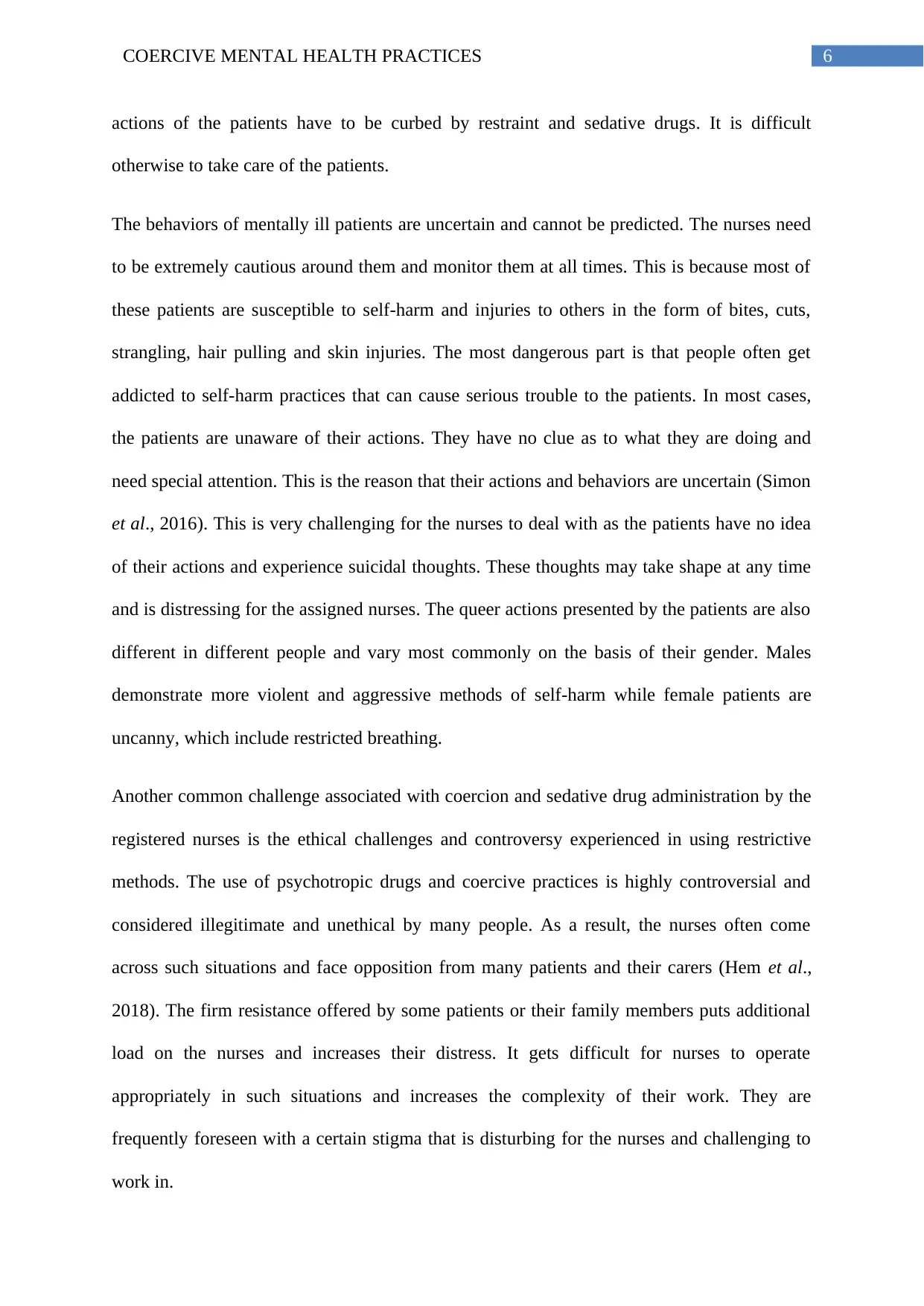
6COERCIVE MENTAL HEALTH PRACTICES
actions of the patients have to be curbed by restraint and sedative drugs. It is difficult
otherwise to take care of the patients.
The behaviors of mentally ill patients are uncertain and cannot be predicted. The nurses need
to be extremely cautious around them and monitor them at all times. This is because most of
these patients are susceptible to self-harm and injuries to others in the form of bites, cuts,
strangling, hair pulling and skin injuries. The most dangerous part is that people often get
addicted to self-harm practices that can cause serious trouble to the patients. In most cases,
the patients are unaware of their actions. They have no clue as to what they are doing and
need special attention. This is the reason that their actions and behaviors are uncertain (Simon
et al., 2016). This is very challenging for the nurses to deal with as the patients have no idea
of their actions and experience suicidal thoughts. These thoughts may take shape at any time
and is distressing for the assigned nurses. The queer actions presented by the patients are also
different in different people and vary most commonly on the basis of their gender. Males
demonstrate more violent and aggressive methods of self-harm while female patients are
uncanny, which include restricted breathing.
Another common challenge associated with coercion and sedative drug administration by the
registered nurses is the ethical challenges and controversy experienced in using restrictive
methods. The use of psychotropic drugs and coercive practices is highly controversial and
considered illegitimate and unethical by many people. As a result, the nurses often come
across such situations and face opposition from many patients and their carers (Hem et al.,
2018). The firm resistance offered by some patients or their family members puts additional
load on the nurses and increases their distress. It gets difficult for nurses to operate
appropriately in such situations and increases the complexity of their work. They are
frequently foreseen with a certain stigma that is disturbing for the nurses and challenging to
work in.
actions of the patients have to be curbed by restraint and sedative drugs. It is difficult
otherwise to take care of the patients.
The behaviors of mentally ill patients are uncertain and cannot be predicted. The nurses need
to be extremely cautious around them and monitor them at all times. This is because most of
these patients are susceptible to self-harm and injuries to others in the form of bites, cuts,
strangling, hair pulling and skin injuries. The most dangerous part is that people often get
addicted to self-harm practices that can cause serious trouble to the patients. In most cases,
the patients are unaware of their actions. They have no clue as to what they are doing and
need special attention. This is the reason that their actions and behaviors are uncertain (Simon
et al., 2016). This is very challenging for the nurses to deal with as the patients have no idea
of their actions and experience suicidal thoughts. These thoughts may take shape at any time
and is distressing for the assigned nurses. The queer actions presented by the patients are also
different in different people and vary most commonly on the basis of their gender. Males
demonstrate more violent and aggressive methods of self-harm while female patients are
uncanny, which include restricted breathing.
Another common challenge associated with coercion and sedative drug administration by the
registered nurses is the ethical challenges and controversy experienced in using restrictive
methods. The use of psychotropic drugs and coercive practices is highly controversial and
considered illegitimate and unethical by many people. As a result, the nurses often come
across such situations and face opposition from many patients and their carers (Hem et al.,
2018). The firm resistance offered by some patients or their family members puts additional
load on the nurses and increases their distress. It gets difficult for nurses to operate
appropriately in such situations and increases the complexity of their work. They are
frequently foreseen with a certain stigma that is disturbing for the nurses and challenging to
work in.
Paraphrase This Document
Need a fresh take? Get an instant paraphrase of this document with our AI Paraphraser
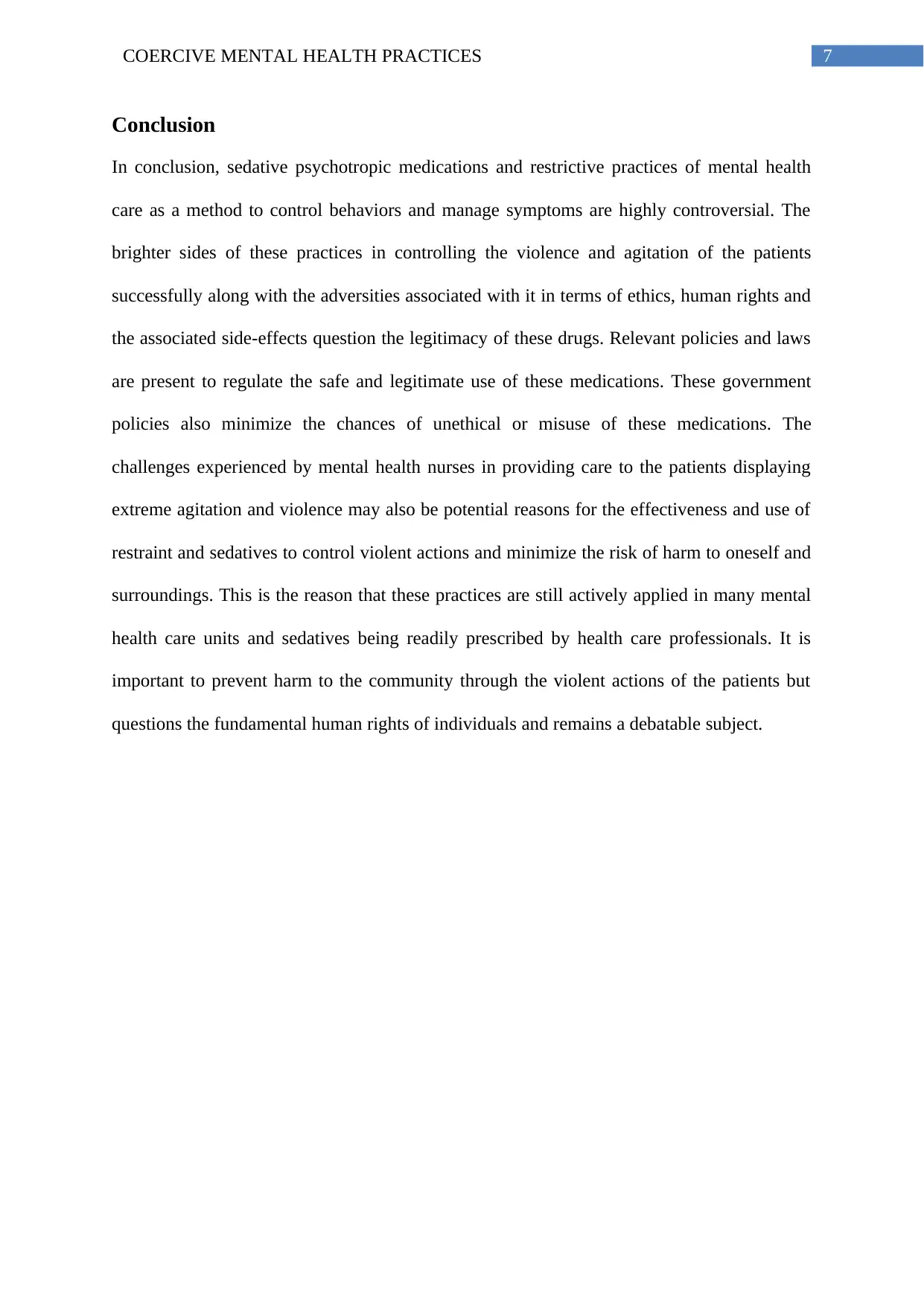
7COERCIVE MENTAL HEALTH PRACTICES
Conclusion
In conclusion, sedative psychotropic medications and restrictive practices of mental health
care as a method to control behaviors and manage symptoms are highly controversial. The
brighter sides of these practices in controlling the violence and agitation of the patients
successfully along with the adversities associated with it in terms of ethics, human rights and
the associated side-effects question the legitimacy of these drugs. Relevant policies and laws
are present to regulate the safe and legitimate use of these medications. These government
policies also minimize the chances of unethical or misuse of these medications. The
challenges experienced by mental health nurses in providing care to the patients displaying
extreme agitation and violence may also be potential reasons for the effectiveness and use of
restraint and sedatives to control violent actions and minimize the risk of harm to oneself and
surroundings. This is the reason that these practices are still actively applied in many mental
health care units and sedatives being readily prescribed by health care professionals. It is
important to prevent harm to the community through the violent actions of the patients but
questions the fundamental human rights of individuals and remains a debatable subject.
Conclusion
In conclusion, sedative psychotropic medications and restrictive practices of mental health
care as a method to control behaviors and manage symptoms are highly controversial. The
brighter sides of these practices in controlling the violence and agitation of the patients
successfully along with the adversities associated with it in terms of ethics, human rights and
the associated side-effects question the legitimacy of these drugs. Relevant policies and laws
are present to regulate the safe and legitimate use of these medications. These government
policies also minimize the chances of unethical or misuse of these medications. The
challenges experienced by mental health nurses in providing care to the patients displaying
extreme agitation and violence may also be potential reasons for the effectiveness and use of
restraint and sedatives to control violent actions and minimize the risk of harm to oneself and
surroundings. This is the reason that these practices are still actively applied in many mental
health care units and sedatives being readily prescribed by health care professionals. It is
important to prevent harm to the community through the violent actions of the patients but
questions the fundamental human rights of individuals and remains a debatable subject.
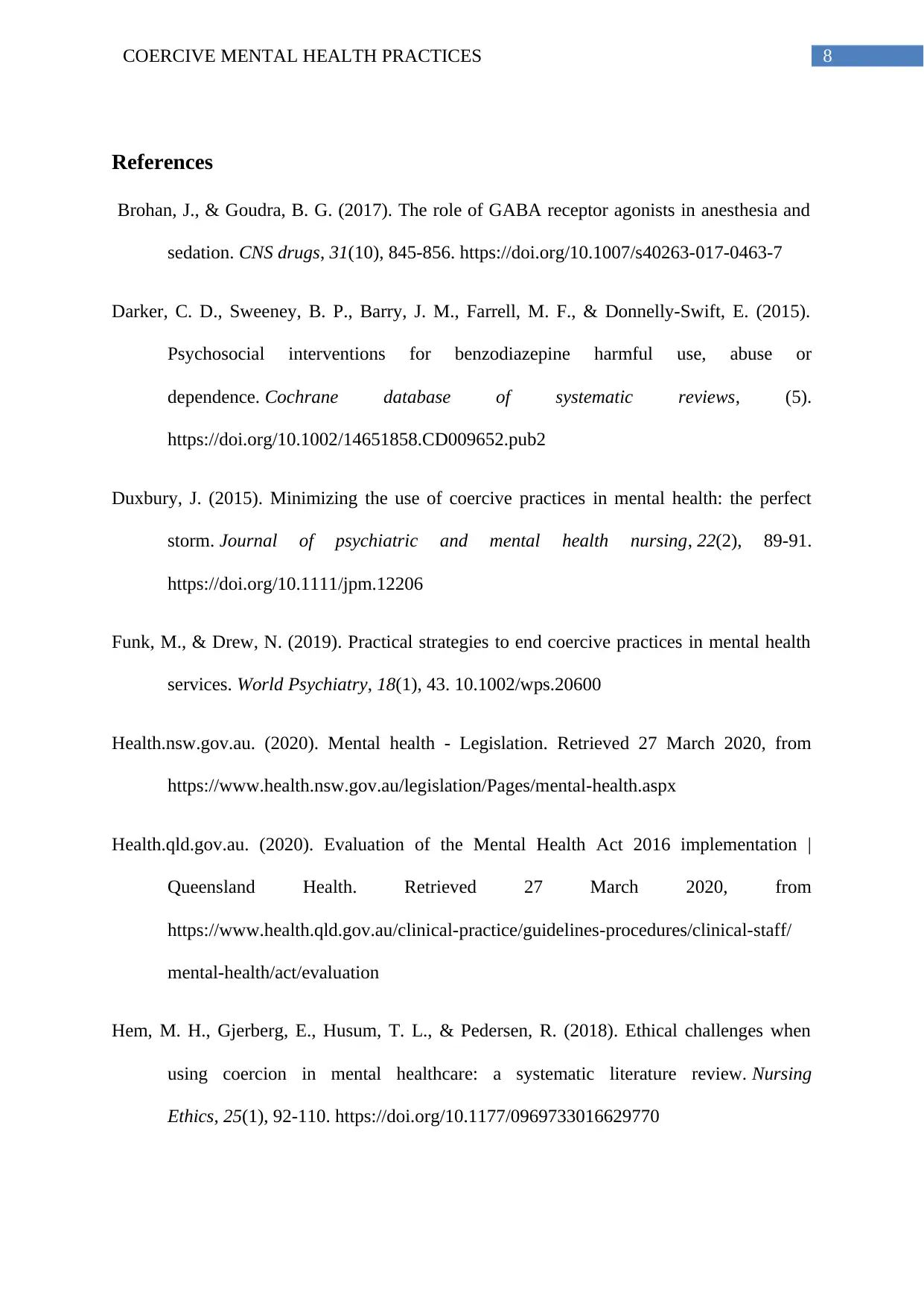
8COERCIVE MENTAL HEALTH PRACTICES
References
Brohan, J., & Goudra, B. G. (2017). The role of GABA receptor agonists in anesthesia and
sedation. CNS drugs, 31(10), 845-856. https://doi.org/10.1007/s40263-017-0463-7
Darker, C. D., Sweeney, B. P., Barry, J. M., Farrell, M. F., & Donnelly‐Swift, E. (2015).
Psychosocial interventions for benzodiazepine harmful use, abuse or
dependence. Cochrane database of systematic reviews, (5).
https://doi.org/10.1002/14651858.CD009652.pub2
Duxbury, J. (2015). Minimizing the use of coercive practices in mental health: the perfect
storm. Journal of psychiatric and mental health nursing, 22(2), 89-91.
https://doi.org/10.1111/jpm.12206
Funk, M., & Drew, N. (2019). Practical strategies to end coercive practices in mental health
services. World Psychiatry, 18(1), 43. 10.1002/wps.20600
Health.nsw.gov.au. (2020). Mental health - Legislation. Retrieved 27 March 2020, from
https://www.health.nsw.gov.au/legislation/Pages/mental-health.aspx
Health.qld.gov.au. (2020). Evaluation of the Mental Health Act 2016 implementation |
Queensland Health. Retrieved 27 March 2020, from
https://www.health.qld.gov.au/clinical-practice/guidelines-procedures/clinical-staff/
mental-health/act/evaluation
Hem, M. H., Gjerberg, E., Husum, T. L., & Pedersen, R. (2018). Ethical challenges when
using coercion in mental healthcare: a systematic literature review. Nursing
Ethics, 25(1), 92-110. https://doi.org/10.1177/0969733016629770
References
Brohan, J., & Goudra, B. G. (2017). The role of GABA receptor agonists in anesthesia and
sedation. CNS drugs, 31(10), 845-856. https://doi.org/10.1007/s40263-017-0463-7
Darker, C. D., Sweeney, B. P., Barry, J. M., Farrell, M. F., & Donnelly‐Swift, E. (2015).
Psychosocial interventions for benzodiazepine harmful use, abuse or
dependence. Cochrane database of systematic reviews, (5).
https://doi.org/10.1002/14651858.CD009652.pub2
Duxbury, J. (2015). Minimizing the use of coercive practices in mental health: the perfect
storm. Journal of psychiatric and mental health nursing, 22(2), 89-91.
https://doi.org/10.1111/jpm.12206
Funk, M., & Drew, N. (2019). Practical strategies to end coercive practices in mental health
services. World Psychiatry, 18(1), 43. 10.1002/wps.20600
Health.nsw.gov.au. (2020). Mental health - Legislation. Retrieved 27 March 2020, from
https://www.health.nsw.gov.au/legislation/Pages/mental-health.aspx
Health.qld.gov.au. (2020). Evaluation of the Mental Health Act 2016 implementation |
Queensland Health. Retrieved 27 March 2020, from
https://www.health.qld.gov.au/clinical-practice/guidelines-procedures/clinical-staff/
mental-health/act/evaluation
Hem, M. H., Gjerberg, E., Husum, T. L., & Pedersen, R. (2018). Ethical challenges when
using coercion in mental healthcare: a systematic literature review. Nursing
Ethics, 25(1), 92-110. https://doi.org/10.1177/0969733016629770
⊘ This is a preview!⊘
Do you want full access?
Subscribe today to unlock all pages.

Trusted by 1+ million students worldwide
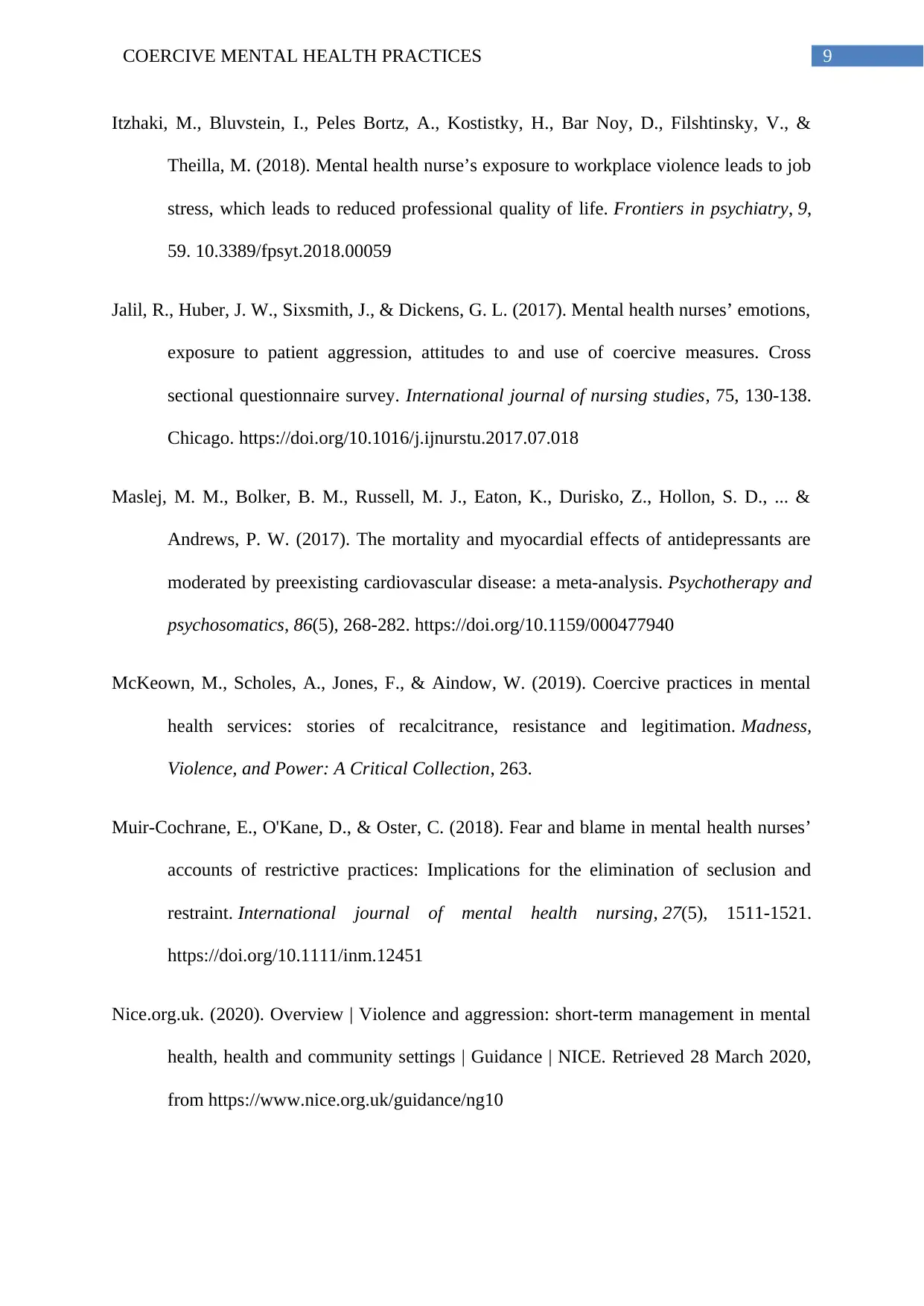
9COERCIVE MENTAL HEALTH PRACTICES
Itzhaki, M., Bluvstein, I., Peles Bortz, A., Kostistky, H., Bar Noy, D., Filshtinsky, V., &
Theilla, M. (2018). Mental health nurse’s exposure to workplace violence leads to job
stress, which leads to reduced professional quality of life. Frontiers in psychiatry, 9,
59. 10.3389/fpsyt.2018.00059
Jalil, R., Huber, J. W., Sixsmith, J., & Dickens, G. L. (2017). Mental health nurses’ emotions,
exposure to patient aggression, attitudes to and use of coercive measures. Cross
sectional questionnaire survey. International journal of nursing studies, 75, 130-138.
Chicago. https://doi.org/10.1016/j.ijnurstu.2017.07.018
Maslej, M. M., Bolker, B. M., Russell, M. J., Eaton, K., Durisko, Z., Hollon, S. D., ... &
Andrews, P. W. (2017). The mortality and myocardial effects of antidepressants are
moderated by preexisting cardiovascular disease: a meta-analysis. Psychotherapy and
psychosomatics, 86(5), 268-282. https://doi.org/10.1159/000477940
McKeown, M., Scholes, A., Jones, F., & Aindow, W. (2019). Coercive practices in mental
health services: stories of recalcitrance, resistance and legitimation. Madness,
Violence, and Power: A Critical Collection, 263.
Muir‐Cochrane, E., O'Kane, D., & Oster, C. (2018). Fear and blame in mental health nurses’
accounts of restrictive practices: Implications for the elimination of seclusion and
restraint. International journal of mental health nursing, 27(5), 1511-1521.
https://doi.org/10.1111/inm.12451
Nice.org.uk. (2020). Overview | Violence and aggression: short-term management in mental
health, health and community settings | Guidance | NICE. Retrieved 28 March 2020,
from https://www.nice.org.uk/guidance/ng10
Itzhaki, M., Bluvstein, I., Peles Bortz, A., Kostistky, H., Bar Noy, D., Filshtinsky, V., &
Theilla, M. (2018). Mental health nurse’s exposure to workplace violence leads to job
stress, which leads to reduced professional quality of life. Frontiers in psychiatry, 9,
59. 10.3389/fpsyt.2018.00059
Jalil, R., Huber, J. W., Sixsmith, J., & Dickens, G. L. (2017). Mental health nurses’ emotions,
exposure to patient aggression, attitudes to and use of coercive measures. Cross
sectional questionnaire survey. International journal of nursing studies, 75, 130-138.
Chicago. https://doi.org/10.1016/j.ijnurstu.2017.07.018
Maslej, M. M., Bolker, B. M., Russell, M. J., Eaton, K., Durisko, Z., Hollon, S. D., ... &
Andrews, P. W. (2017). The mortality and myocardial effects of antidepressants are
moderated by preexisting cardiovascular disease: a meta-analysis. Psychotherapy and
psychosomatics, 86(5), 268-282. https://doi.org/10.1159/000477940
McKeown, M., Scholes, A., Jones, F., & Aindow, W. (2019). Coercive practices in mental
health services: stories of recalcitrance, resistance and legitimation. Madness,
Violence, and Power: A Critical Collection, 263.
Muir‐Cochrane, E., O'Kane, D., & Oster, C. (2018). Fear and blame in mental health nurses’
accounts of restrictive practices: Implications for the elimination of seclusion and
restraint. International journal of mental health nursing, 27(5), 1511-1521.
https://doi.org/10.1111/inm.12451
Nice.org.uk. (2020). Overview | Violence and aggression: short-term management in mental
health, health and community settings | Guidance | NICE. Retrieved 28 March 2020,
from https://www.nice.org.uk/guidance/ng10
Paraphrase This Document
Need a fresh take? Get an instant paraphrase of this document with our AI Paraphraser
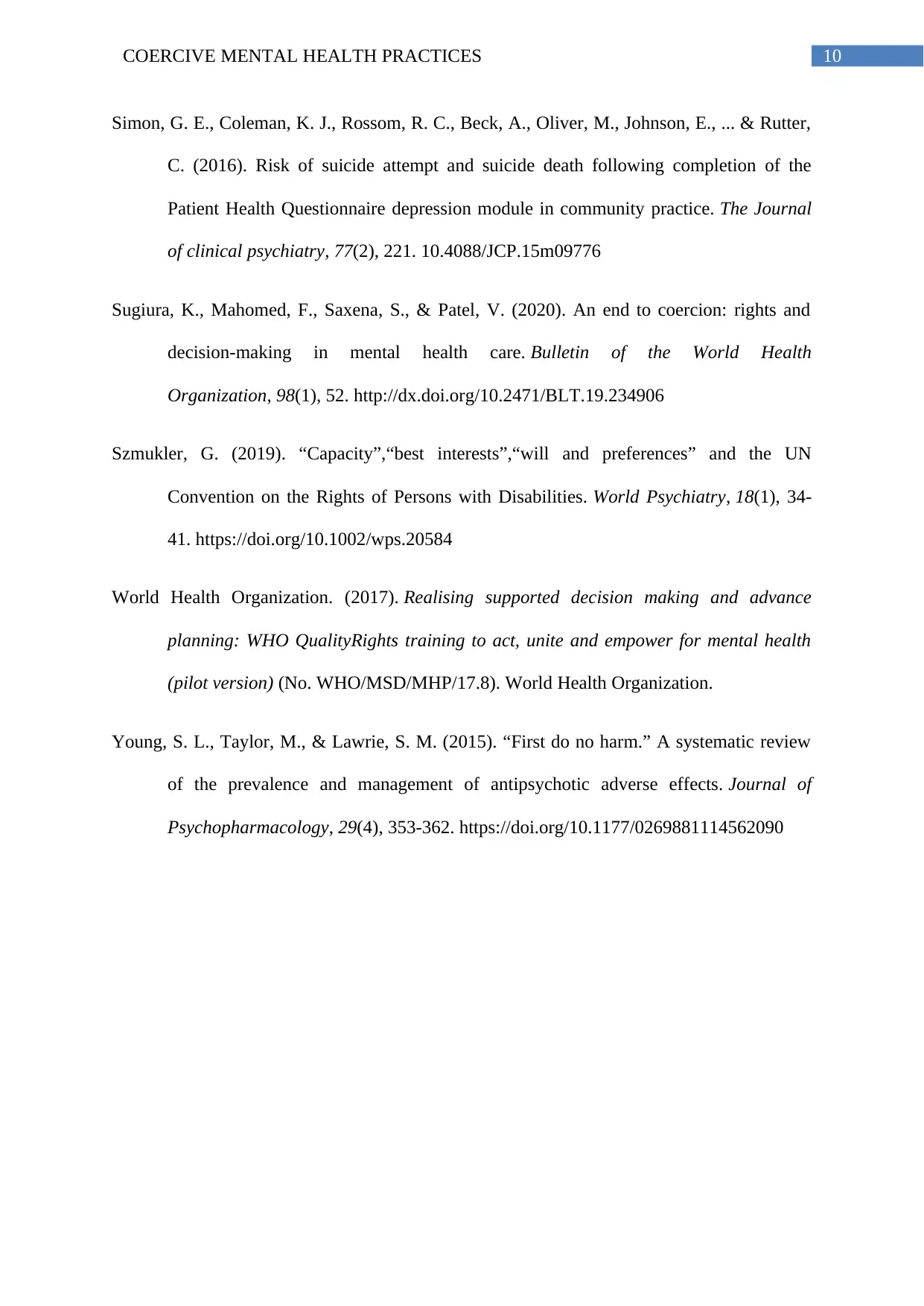
10COERCIVE MENTAL HEALTH PRACTICES
Simon, G. E., Coleman, K. J., Rossom, R. C., Beck, A., Oliver, M., Johnson, E., ... & Rutter,
C. (2016). Risk of suicide attempt and suicide death following completion of the
Patient Health Questionnaire depression module in community practice. The Journal
of clinical psychiatry, 77(2), 221. 10.4088/JCP.15m09776
Sugiura, K., Mahomed, F., Saxena, S., & Patel, V. (2020). An end to coercion: rights and
decision-making in mental health care. Bulletin of the World Health
Organization, 98(1), 52. http://dx.doi.org/10.2471/BLT.19.234906
Szmukler, G. (2019). “Capacity”,“best interests”,“will and preferences” and the UN
Convention on the Rights of Persons with Disabilities. World Psychiatry, 18(1), 34-
41. https://doi.org/10.1002/wps.20584
World Health Organization. (2017). Realising supported decision making and advance
planning: WHO QualityRights training to act, unite and empower for mental health
(pilot version) (No. WHO/MSD/MHP/17.8). World Health Organization.
Young, S. L., Taylor, M., & Lawrie, S. M. (2015). “First do no harm.” A systematic review
of the prevalence and management of antipsychotic adverse effects. Journal of
Psychopharmacology, 29(4), 353-362. https://doi.org/10.1177/0269881114562090
Simon, G. E., Coleman, K. J., Rossom, R. C., Beck, A., Oliver, M., Johnson, E., ... & Rutter,
C. (2016). Risk of suicide attempt and suicide death following completion of the
Patient Health Questionnaire depression module in community practice. The Journal
of clinical psychiatry, 77(2), 221. 10.4088/JCP.15m09776
Sugiura, K., Mahomed, F., Saxena, S., & Patel, V. (2020). An end to coercion: rights and
decision-making in mental health care. Bulletin of the World Health
Organization, 98(1), 52. http://dx.doi.org/10.2471/BLT.19.234906
Szmukler, G. (2019). “Capacity”,“best interests”,“will and preferences” and the UN
Convention on the Rights of Persons with Disabilities. World Psychiatry, 18(1), 34-
41. https://doi.org/10.1002/wps.20584
World Health Organization. (2017). Realising supported decision making and advance
planning: WHO QualityRights training to act, unite and empower for mental health
(pilot version) (No. WHO/MSD/MHP/17.8). World Health Organization.
Young, S. L., Taylor, M., & Lawrie, S. M. (2015). “First do no harm.” A systematic review
of the prevalence and management of antipsychotic adverse effects. Journal of
Psychopharmacology, 29(4), 353-362. https://doi.org/10.1177/0269881114562090
1 out of 11
Related Documents
Your All-in-One AI-Powered Toolkit for Academic Success.
+13062052269
info@desklib.com
Available 24*7 on WhatsApp / Email
![[object Object]](/_next/static/media/star-bottom.7253800d.svg)
Unlock your academic potential
© 2024 | Zucol Services PVT LTD | All rights reserved.





